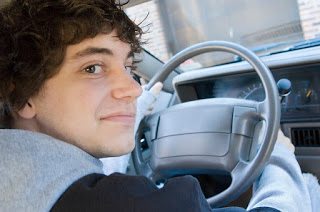Category Archive: Parents

Study Shows That GDL Laws Work; To An Extent
July 30, 2012
A study published in the Journal of the American Medical Association in September 2011 shows that the death rate for teen drivers under the age of 18 has fallen dramatically over the past several years. However, the good news in this study comes with a downside; the rate of fatal crashes for teen drivers over the age of 18 has risen. The reason for the increase isn’t totally certain but there are a couple of factors that some feel have led to the increase.
The Graduated Driving License (GDL) laws are working as they were designed. GDL laws place restrictions on new teen drivers that limit the number of passengers they can carry, the hours that they can drive, and their ability to use cell phones while driving. These laws were designed to limit all of the distractions that lead to so many teen deaths and, according to the researchers, they have resulted in 1,348 fewer crashes among 16 year olds.
Part of the reason for the increase in the death rate for 18 year olds is that they are now free of those restrictions and, with more passengers in the car and the ability to drive late a t night, they may be entering into driving situations that they have never experienced before and are unable to cope with.
Another reason that some experts have noted is that, with the restrictions placed on 16 year olds to complete driver training prior to getting their license, many teens are now waiting until they are 18 before getting a license. At the age of 18, there is often no requirement for any type of formal classroom or behind the wheel training. The requirement to hold a learner’s permit for a year and document up to 50 hours of supervised driving experience is also lifted for 18 year olds.
By waiting until they are 18, these drivers can often get their license in just a few weeks by passing what is generally a pretty easy driving test at the DMV. They are foregoing a lot of good training that teaches them the skills necessary to avoid collisions on the road.
If you have a teen at home that is waiting until age 18, you should insist that he or she still take all of the required courses required of 16 year olds and get at least 50 hours (ten at night) of supervised driving experience before allowing them to get their license.

Car Surfing and Riding Outside the Vehicle
May 11, 2012
Recently, news reports have told the story of at least five teens that were severely injured as a result of “car surfing”, or riding outside a vehicle.
In one incident, a 14 year old Georgia boy was riding in the trunk of a vehicle overloaded with teens. He was ejected from the vehicle and suffered severe brain injury. He remained in the intensive care unit for three weeks until he was taken off life support and died. The 19 year old driver is now facing charges in the incident.
In another incident from Georgia, a 16 year old boy skipped school with several others and was hanging outside an SUV traveling at a high rate of speed. The driver lost control and the SUV rolled crushing the teen underneath. At last report, he remains in a coma.
Two girls, one from Pennsylvania and another from Florida were injured while attempting to car-surf. Car surfing involves trying to remain upright or “surfing” on top of a moving vehicle. The Pennsylvania girl was taken to the hospital in critical condition. The Florida girl remains in a medically induced coma.
Another 17 year old boy was trying to hold down a mattress in the back of a pickup truck traveling at approximately 35 to 40 mph. The airstream, both above and below the mattress, created a wing-like effect, lifting the mattress along with the boy into the air. The boy died due to massive brain trauma.
Teens tend to feel invincible but no matter how strong, athletic or agile they may be, they will never be strong or agile enough to overcome the laws of physics. An object in motion tends to remain in motion in a straight line. That means that, while attempting to car-surf, if the vehicle should suddenly stop or turn, the “surfer” will continue traveling ahead at the same rate of speed, usually crashing into the pavement. Even at speeds as low as 10 to 15 mph, the results can be catastrophic.
Even inside the vehicle, if they aren’t wearing a seat belt, they are asking for trouble. Another recent incident involved a teen girl who was engaged in horseplay with her boyfriend while the vehicle was in motion. Authorities are unsure of what exactly happened but it is felt that the girl accidentally hit the door handle, opening the door. Not wearing a seat belt, she was thrown out of the vehicle and suffered traumatic brain injury.
Most of these incidents involved teens engaged in horseplay in or on a moving vehicle without a seat belt to hold them in place; most also involved cars driven by a teen with more than one other passenger. Graduated driving laws in most states usually restrict the number of passengers a teen can carry because it is well proven that, the more teen passengers a teen driver carries, the greater the distractions and the greater the temptation to show off.
Teens and adults need to be constantly reminded that there is no safe place on or in a vehicle except in a passenger seat securely buckled in with a seat belt.

Teen Emotions and Driving
May 5, 2012
Upset? Angry? Emotional? We all get that way. It is a natural part of life and sometimes a natural part of the day. Life and events are out of our control and so we all are thrown hurdles to get through; many times unexpectedly. Dealing with the emotions of what comes along can be complicated. But what you want to avoid is getting behind the wheel when you are emotional, angry or upset.
Many times people let their emotions get the best of them. When you are driving, you have to be able to give it your full attention. The attitude you have is your state of mind at any given moment, whether that be happy or sad, excited or full of anxiety.
Your state of mind controls how you behave and react to situations. The actions and reactions are a normal part of everyday living and interaction with others. When you are emotional behind the wheel, it can interfere with your ability to think clearly and inadvertently create a mental distraction.
For instance, if you are worried or upset or thinking through a complicated issue while driving, you may not notice your upcoming exit or turn, causing you to miss it or react suddenly. You become an inattentive driver. You may fail to scan the environment ahead or notice debris in the roadway. When you are angry or upset, you may increase your risk taking and pull out in front of another vehicle, cut someone off, or tailgate.
Positive emotions are dangerous too. Even when you’ve received the best of news there can be a lack of concentration when you get behind the wheel leading to increased reaction times. You can lose your ability to notice what other drivers are doing, anticipate their next moves and determine how you will respond.
Driving when emotions are high can interrupt your ability to process information in the driving environment and incite you to act out your emotions. You can lose your ability to perform skills that require precise timing to complete. Physically, your body can react in many ways including increases in heart beat and respiration rates and spikes adrenaline levels.
Teens’ brains are still developing and are very vulnerable to their emotions and the emotions of others. They usually have less means and independence than they would like, which can increase their frustrations and intensify their emotions.
So what do you do?
- Set a good example and choose not to drive when upset.
- Recognize the role emotions play when driving. Look at examples of other drivers on the roadway who maybe mental distracted and discuss the danger they pose together.
- Examine your and your teenager’s emotional make up and discuss coping strategies.
- Identify and predict situations that could cause both positive and negative emotions.
- Ask for a commitment from your teen to delay driving when they are emotional or upset. Get a verbal agreement and include it in your Parent & Teen Driving Contract.
What are some coping strategies?
- If you are excited or upset, ask someone else to drive you.
- Give yourself a few minutes and quiet your mind. Close your eyes and take a several deep breaths.
- Remember that you can’t control what happens to you, you can only control how you respond to it and many times that determines your ultimate success.
- Separate the actions, reactions and emotions from the people and the situations: John’s immature vs. John’s acting immature.
- If you can, take a short walk or do some quick exercises to settle your body down.
- Leave a few minutes early to give yourself extra time to get to your destination, so you won’t be hurried.
If you become upset while you are driving, pull over to a safe place. Take a few minutes, walk around, and breathe deeply. Avoid the risk and avoid the consequences…Drive with a safe attitude.
Learn more about the Facts Behind Teen Crashes.

Teen Death Rates Decline In States With Strong Graduated Driver License Laws
April 2, 2012
A 2006 study by the Johns Hopkins Bloomberg School of Public Health that showed Graduated Driver License Laws (GDLs) reduced teen death rates by an average of 11% has been backed up by at least two states that have shown a significant decline in their teen fatality rate after enactment of tough new GDLs.
New Jersey’s strong GDL laws will become even stronger with new GDL regulations as a result of recommendations by the Teen Driver Study Commission. The new laws or regulations are:
- No plea bargains for GDL holders (teens can’t plea bargain away points for traffic violations). Teens who accumulate 3 or more points, must attend a 4-hour MVC Probationary Driver Program and be monitored for 12 months. Any accumulation of points during the monitoring period will result in a 90 day license suspension.
- Use of a decal on the vehicle to identify drivers who hold a learner’s permit or provisional license.
- 11 PM curfew for all drivers under the age of 21 who hold a permit or provisional license.
- Limit of passengers to just one – regardless of family affiliation.
The Illinois Secretary of State introduced figures that showed a 53% drop in teen deaths between 2007 and the first 9 months of 2009. Illinois sanctions on drivers during the Initial Licensing Phase include:
- Two moving violation convictions occurring within a 24-month period will result in a minimum one-month driver’s license suspension. Suspension length is determined by the seriousness of the offenses and the driver’s prior driving history. An additional driver’s license suspension will result for each subsequent moving violation following the initial suspension.
- Any moving violation conviction that occurs within the first year of licensure will result in a six-month extension of the passenger limitation, which allows no more than one unrelated passenger under age 20.
- Suspended drivers are required to attend a remedial education course, may be retested and must pay a $70 reinstatement fee.
Parents who don’t live in a state with a strong GDL law, can impose their own strict restrictions. If you are not sure what the GDL law is in your state, visit your state’s web site or: http://www.iihs.org/iihs/topics/t/teenagers/qanda#teenagers–graduated-driver-licensing

Survivor’s Guilt: Teens in Motor Vehicle Crashes
February 21, 2012
A single car crash in North Carolina last month led to the death of the driver’s twin sister.
Another news report from the past month regarding a teen who had been killed in a single vehicle car crash the teen’s girl friend was quoted as saying:
“Cameron was drinking and we got into a fight. I told him to find another ride home. I said, ‘Get out of this car, you’re being disrespectful,'” Talia said, gasping between tears and raising her arms to the sky. “Why didn’t I drive him home?”
Survivor’s guilt, which is most often associated with victims of combat, can occur in anyone who has survived any type of trauma whether they were directly involved or not. The guilt from wishing they had done something different that may have averted the event can lead to long-lasting psychological problems. The most common form of psychological trauma resulting from survivor’s guilt is Post Traumatic Stress Disorder (PTSD) which can result in life-long, debilitating problems for the victim. This is why high schools, who experience the death of one of their students, make extra counselors available to the student body immediately after the event.
If your teen has been involved in a crash in which someone died or was horribly injured or even if they were weren’t involved but were closely associated with the victim, you will need to help them through the grief process and you should be on the lookout for the warning signs of PTSD.
Grief – The grief process is something everyone who has experienced the loss of a friend or loved one must go through and it occurs in specific stages;
- Denial and Isolation.
- Anger.
- Bargaining.
- Depression.
- Acceptance.
Guiding your teen through all of the stages to acceptance, can be a long and painful process. If the guilt is left unresolved, it can lead to a multitude of psychological issues.
Don’t try to tell your teen how they should act or feel – No one can truly understand how a grieving person feels and trying to tell them their emotions are wrong or unhealthy can only compound the problem. Instead, sympathize and let him or her vent their feelings. Holding in or suppressing one’s feelings can be harmful.
Suggest that they express their grief in a creative way – One example of a creative expression of grief is the Facebook page mentioned in the first article of this newsletter. Writing a song or a poem, creating a memorial to the victim are all positive expressions of grief. Getting involved in programs to prevent future tragedies can give your teen some sense of control over events.
Watch for signs that your teen may be “numbing out” – One common expression of grief is to try to suppress the feelings by turning to alcohol or drugs. This is an especially dangerous form of expression and can only make matters worse.
Withdrawing from friends and events – Your teen my stop engaging in their usual activities or back away from friendships. This part of the denial and isolation stage is designed to prevent any future relationships and thus, the chance of losing someone else that may be close to them. To make up for the lack of relationships, your teen may turn to alcohol or drugs or withdraw into video games. Their school performance may suffer.
Grief Triggers – There will be times when reminders of the loss of their friend will be especially acute; such as anniversaries of the event, birthdays, school proms, graduation. Be aware of these triggers and be prepared to help your teen through the grief process all over again.
Talk, talk, talk, talk, talk – Trying to put the past behind you by ignoring the fact that the event happened won’t make it go away. Talking through the issues is the best form of grief expression. Be there for your teen, allow them to talk it out and listen without judging.
Don’t be afraid to seek professional counseling – Unresolved, PTSD can lead to severe depression, paranoia, isolation, and drug dependence. If left unresolved, these issues can affect future generations. Be on the lookout for warning signs and understand that the issues may be too big for you to handle. Seek professional psychological help.
